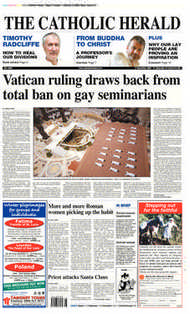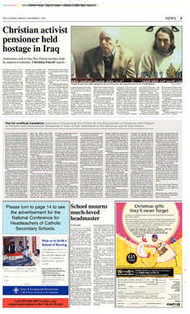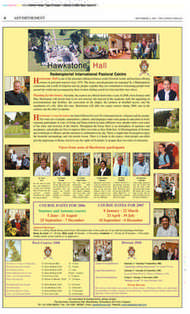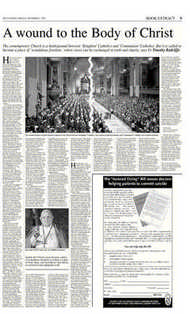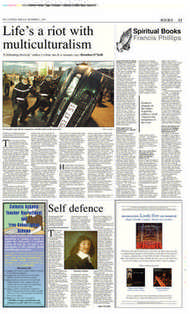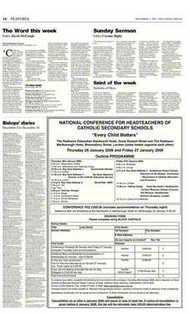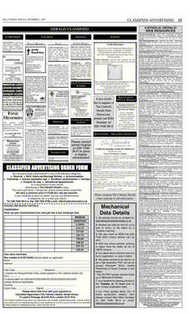Page 1, 2nd December 2005
Page 1
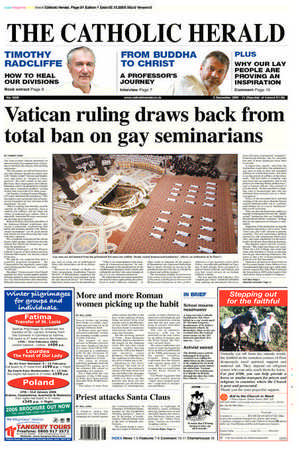
Report an error
Noticed an error on this page?If you've noticed an error in this article please click here to report it.
Tags
Share
Related articles
Pope Ponders Cdf Document Prompted By American Crisis
Seminaries Under The Microscope As Gay Ruling Hangs In...
The Catholic Herald
Bar On Gay Seminarians Is ‘not Discrimination’, Say...
Jesuit Provincial Leads Backlash Against Gay Priests...
Vatican Notes Progress In Us Seminaries
Vatican ruling draws back from total ban on gay seminarians
BY FREDDY GRAY
THE long-awaited Vatican document on homosexuality has stopped short of placing an absolute ban on gay men entering seminaries.
The document, an official Instruction, says that bishops should not ordain men with “deeply rooted” homosexual tendencies, and refers to “negative consequences” this had caused in the past. However, the Congregation for Catholic Education said it was prepared to consider men with a “transitory problem” so long as they had overcome it for three years.
On Tuesday, Cardinal Cormac MurphyO’Connor defended the Instruction. “The document is not saying that men of homosexual orientation are not welcome in the priesthood,” he said.
“But it is making clear that they must be capable of affective maturity, have a capacity for celibacy and not share the values of eroticised gay culture. This is especially important because seminaries are all-male environments.” Bishop William Skylstad, president of the American bishops’ conference, also issued a statement, emphasising that priests and seminary students with “homosexual inclinations” can be good priests and should not fear discussing the issue with their superiors.
His comments contradicted the claims of gay rights groups, which insist that the Vatican has effectively banned gay men from the priesthood.
Martin Pendergast, of the Roman Catholic Caucus of the Lesbian and Gay Christian Movement, was fiercely critical of the text.
He said he was surprised that such a carefully prepared document – the Congregation has reportedly spent eight years producing the final text – could be “so flawed”.
He added: “It does exactly what Church teaching has often warned against: namely, defining people by their sexual orientation in a way that diminishes their humanity. What this instruction seems to do is to see gay men as some sort of pathological class with whom there can be no discussion.” However, in a debate on Radio 4’s Today programme, Archbishop Vincent Nichols of Birmingham supported the document, which he said contained “helpful and practical advice” for bishops to help them choose men for the priesthood. “There is no condemnation in this document of a homosexual person,” he said. “The demands of the priesthood are on the wholehearted attempt to lead a chaste and celibate life and that’s the same demand on me as it is on a homosexual person.” He added that the document underlines the need for those approaching the priesthood to reach “affective maturity – in other words to integrate all the aspects of themselves into a personal dedication that is clearly focused on service to the priesthood and on a life that is to be led in a chaste and celibate manner.” The document, entitled An Instruction Concerning Criteria for the Discernment of Vocations with Regard to Persons with Homosexual Tendencies in View of their Admission to the Seminary and to Holy Orders, was officially published on Tuesday. It had already been circulated to senior Church officials and bishops and was last week posted on an Italian Catholic website.
The text specifies that Catholics who “support gay culture” should be forbidden from entering the priesthood. However, men who have experienced “transitory” homosexual feelings may be ordained, but only if those tendencies have been overcome.
A report last month said that the Instruction would allow the ordination of gay men as long as they had remained celibate for at least three years. But there is no discussion of celibacy in the document. “The text refers to someone who may have had an experience tied to the process of maturing during adolescence,” said a Vatican official, who refused to give his name. “It does not refer to someone who is homosexual and who has refrained from [sexual] acts in a threeyear period.” Critics of the document have said that wording of the text shows that the Vatican regards homosexuality not as a permanent identity but as a set of “tendencies” that can be overcome.
They say that the Instruction makes no attempt to distinguish between the “deeply rooted” tendencies that are forbidden in the priesthood and the “transitory” feelings that do not represent an obstacle to ordination.
Supporters of the Instruction say that the document represents a move away from “don’t ask, don’t tell” attitude to priestly sexuality. The text encourages spiritual directors to ask seminarians about sexuality, and urges candidates for the priesthood to be honest about their inclinations.
One English priest told The Catholic Herald: “This could have been a lot worse. There are a lot of things one could take issue with, but there is clearly no absolute ban on gay men entering seminaries. My guess is that a lot of horse-trading has gone on over this document.” Opinion is divided over when work on the document began. Some believe it was commissioned eight years ago, while other reports suggest that John Paul II ordered the Instruction in 2002 at the height of the clerical sex abuse scandals in America.
blog comments powered by Disqus


